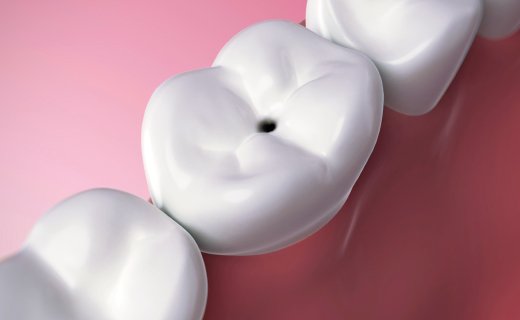Dental cavities are holes in teeth caused by tooth decay. Cavities are caused by tooth decay – a process that occurs over time. Here’s how tooth decay develops:
- Formation of plaque – Your mouth naturally contains many types of bacteria. Some thrive on food and drinks that contain certain forms of sugar. When these sugars aren’t cleaned off your teeth, the bacteria quickly begin feeding on them and producing acids. The bacteria, form bacterial plaque — a sticky film that coats your teeth. If the plaque is not removed while it’s soft, it becomes hard and difficult to remove — a good place for bacteria to hide.
- Plaque attacks – The acids in plaque remove minerals in your tooth’s hard, outer enamel. This erosion causes tiny openings or holes in the enamel — the first stage of cavities. Once areas of enamel are worn away, the bacteria and acid can reach the next layer of your teeth, called dentin. This layer is softer than enamel and less resistant to acid.
- Destruction – As tooth decay develops, the bacteria and acid continue their march through your teeth, moving next to the inner tooth material (pulp) that contains nerves and blood vessels. The pulp becomes swollen and irritated from the bacteria. When decay advances to this extent, you may have a severe toothache, sensitivity, pain when biting or other symptoms. Your body also may respond to these bacterial invaders by sending white blood cells to fight the infection. This may result in a tooth abscess — a pocket of pus that’s caused by a bacterial infection.
Prevention:
There are two main factors to preventing them: oral hygiene and diet change. Good oral hygiene includes brushing your teeth at least twice a day and flossing at least once, having a professional teeth-cleaning every six months, and having X-rays and a dental exam as recommended to detect cavity development.
Reducing the amount of sugar — especially sugary drinks and juices — can help prevent cavities. You may consider rinsing your mouth after eating sticky foods.
Dental sealants may help prevent cavities and are most frequently applied to the teeth of children after their molars come in. Sealants are thin, plastic-like coatings on the surface of the molars that prevent the accumulation of plaque.
Fluoride is another cavity-prevention strategy. It can be consumed in drinking water or as a supplement. Topical fluoride is frequently applied as part of routine dentist visits.

